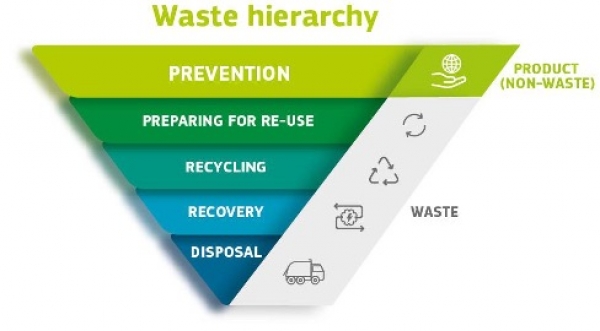The EU waste hierarchy
Posted: 7 February 2022
What is it and why does it matter?

What is triangular, has 5 levels, and sets the order of preference for treating waste in the EU? That’s right, it is the EU waste hierarchy. But what is it? Well, the waste hierarchy is just that, a hierarchy of which waste treatment method should always be aimed. Included in the EU Waste Framework Directive, it is part of the greater EU waste policy whose principal goal is to work towards achieving a circular economy in the European Union, and whose focus is on extracting high-quality resources from waste to the highest extent possible. We thought it would be good to explain this hierarchy from a packaging perspective to give you an idea of what the EU thinks about waste so that you can future-proof your business.
Starting at the top of the pyramid, we have prevention. This stage is a bit of a special situation since it does not actually refer directly to waste but to products. Officially it means any measures taken before a substance, material, or product has become waste and reduces the quantity of waste through either re-use or by extending the life span of the product. While perhaps sounding similar to the next level, preparing for re-use, prevention really aims to simply reduce the amount of waste being produced. In terms of packaging, this can be done mostly by designing with just as much material as needed, as any extra will just mean more waste in the end. Alternatively, this could also be by shipping in bulk quantities with less individual packaging for products. While sounding simple, prevention is quite complex and can involve radically changing packaging designs and shipping logistics.
Sometimes waste cannot be prevented, so the next step to deal with waste is preparing for re-use. According to the waste directive, preparing for re-use includes any checking, cleaning, or repair operations that allow products that have become waste to be re-used without further processing. In terms of packaging, this means that products should preferably be designed for re-use, but then also actually dealt with so that they are safe and fit for re-use more than once. Remember the old milk glass bottles? That is an excellent example of reuse, and we have started to see reuse as a concept coming back like in ‘Loop’, which is a global reuse platform that aims to eliminate waste. Even though it sometimes might seem like we have endless amounts of packaging, the materials they are made from our precious, and so are the processes used to create them. Making a product reusable more than once, in a way means we have to manufacture one less, saving both materials and energy.
After a product has been designed with just the necessary amount of materials and cannot be reused, then the level to aim for is recycling. We have talked a lot about the recycling of plastics, and also how to increase the chances of recycling Being able to recycle something goes close in hand with re-use, as in some ways it is just a different type of re-use. Instead of using the product as it was produced, we simply break it down and re-use the materials to create something new. However, the reason why recycling comes just below re-use is that for certain materials, such as plastic and paper, every time you recycle them the quality is worsened. This means that often you cannot use the recycled material to create the same product again, but need to either use it for a different, simpler product or mix in virgin materials to keep the performance. Falling under recycling is also both types of composting (home and industrial), as this is also a way of recycling the material into another format where it can be used further (for example fertilizer).
When a product has finally been recycled as much as possible, the next level to fall back to is recovery. Recovery means when waste can serve a useful purpose by replacing some other materials that normally would have been used to fulfill a specific function. This mainly includes energy recovery from waste, hopefully replacing more conventional forms of energy such as oil and natural gas. The problem with energy recovery is that when burning waste, many of the chemicals and toxins that were in the waste are released into the atmosphere, along with carbon dioxide. Other forms of recovery include recovering chemicals, metal compounds, or other inorganic substances. While not being better than recycling or any of the other levels above, recovery is still beneficial to simply not using the waste for anything.
The last and least preferable option is disposal. Disposal is when the waste generally cannot be reused or recycled, because there are no systems in place to deal with the waste in any other way, or because it is cheap. This mainly includes sending waste to landfills, where some waste might decompose after a while, but often not. Landfills are a danger to our environment and our health, as numerous toxins often leak into the nearby lands and can contaminate water streams. Not to mention that landfills are a major emitter of methane, a harmful greenhouse gas. As mentioned, disposal is really a last resort, for when waste cannot be treated in any other way. If landfills are the only option, then these need to be carefully managed, ensuring that toxins are kept contained and methane is captured and even used as energy. Preferably, there should never be a need for disposal as it goes against the principle of a circular economy.
We at Circulate love packaging, but we also love responsibility and action. By informing our customers on how to choose their packaging and what to think about, following the EU’s guidelines, we can help ensure that businesses are set for the future, doing our part in speeding up the transition to a circular society.
Sources:
https://eur-lex.europa.eu/legal-content/EN/TXT/?uri=CELEX%3A02008L0098-20180705
https://ec.europa.eu/environment/topics/waste-and-recycling/waste-framework-directive_en
https://ec.europa.eu/environment/green-growth/waste-prevention-and-management/index_en.htm